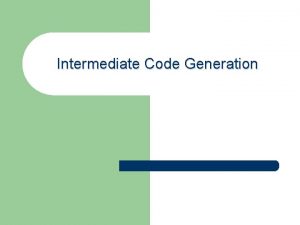Intermediate Macroeconomics Chapter 2 Measuring the Macroeconomy Measuring

































- Slides: 33

Intermediate Macroeconomics Chapter 2 Measuring the Macroeconomy

Measuring the Macroeconomy 1. Measuring Total Output 2. How to Measure GDP 3. Measuring Price Changes Intermediate Macroeconomics

1. Measuring Total Output • Monetary Measure of Value • GDP versus GNP • Omissions from GDP - does not measure social welfare Intermediate Macroeconomics

1. Measuring Total Output Monetary measure of value Quantity times Price equals Market Value Cars 1, 000 x $20, 000 = $20, 000 Dolls 10, 000 x $ Total Value of Output Intermediate Macroeconomics 10 = $ 100, 000 = $20, 100, 000

1. Measuring Total Output GDP versus GNP • Nominal Gross Domestic Product (GDP) the market value of final goods and services produced by a nation during a specific period, usually 1 year. • Nominal Gross National Product (GNP) the market value of final goods and services produced by labor and property supplied by the residents of a nation during a specific period, usually 1 year. Intermediate Macroeconomics

1. Measuring Total Output Omissions from GDP is a poor measure of social welfare: • Leisure • Home and volunteer labor (non market production) • Depletion of nonrenewable resources • Unregulated pollution • Distribution of income • Differences in preferences Intermediate Macroeconomics

2. How to Measure GDP • Expenditure Approach • Income Approach Intermediate Macroeconomics

2. How to Measure GDP Circular flow of income and expenditures Income Resources Business Firms Households Goods and Services Expenditures Solid Lines - Flow of Money Dashed lines - Flow of Goods and Services Intermediate Macroeconomics

2. How to Measure GDP Expenditure approach • GDP = Consumption Spending (C) + Private Domestic Investment (I) + Government Spending (G) + Exports - Imports (net exports, NX) • GDP = C + I + G + NX Intermediate Macroeconomics

2. How to Measure GDP Expenditure approach: Expenditure Shares 2003 U. S. Gross Domestic Product Government Spending 18. 9 % Investment 15. 1 % Net Exports = - 4. 5 % (not shown in slide) Intermediate Macroeconomics Consumption 70. 5 %

2. How to Measure GDP Expenditure Approach: Consumption 1990 -91 recession Real Consumption excluding durables 1981 -82 recession 1973 -75 recession Intermediate Macroeconomics Real GDP

2. How to Measure GDP Expenditure Approach: Investment Gross Investment = Net Investment + Depreciation Intermediate Macroeconomics

2. How to Measure GDP Expenditure approach: Government U. S. Government Spending Share of GDP Intermediate Macroeconomics

2. How to Measure GDP Expenditure Approach: Net exports Trade Deficit Post World War 2 Surplus Imports Exports WW 2 Source: Bureau of Economic Analysis, www. bea. gov Intermediate Macroeconomics

2. How to Measure GDP Income approach • National Income = GDP (with corrections) • Personal Income = National Income (with corrections) • Personal Income - Personal income taxes - Social Security withholding = Disposable Personal Income Intermediate Macroeconomics

3. Measuring Price Changes • Nominal and Real GDP • GDP Deflator • Consumer Price Index • GDP Deflator / CPI Differences • Problems with Traditional Price Indexes • Chain-weighted Price Index Intermediate Macroeconomics

3. Measuring Price Changes Nominal and Real GDP • Nominal GDP – Value of output measured at actual prices (current dollar output) – Does not correct for inflation • Real GDP – Value of output based on prices of some base period (“constant” dollar output) – eliminates effect of inflation Intermediate Macroeconomics

3. Measuring Price Changes Sample problem Intermediate Macroeconomics

3. Measuring Price Changes Definition of Nominal GDP = Current year Quantities x Current year Prices Intermediate Macroeconomics

3. Measuring Price Changes Sample problem: 1992 Nominal GDP = 1992 Quantities x 1992 Prices = 1992 Spending on Food Housing Fun Machines = 4 • $12 + 3 • $9 + 3 • $4 + 2 • $20 = $48 + $27 + $12 + $40 = $127 Intermediate Macroeconomics

3. Measuring Price Changes Sample problem: 1994 Nominal GDP = 1994 Quantities x 1994 Prices = 1994 Spending on Food Housing Fun Machines = 5 • $14 + 3 • $10 + 4 • $5 + 2 • $20 = $70 + $30 + $20 + $40 = $160 Intermediate Macroeconomics

3. Measuring Price Changes Definition of Real GDP = Current year Quantities x Base year Prices Intermediate Macroeconomics

3. Measuring Price Changes Sample problem: 1992 Real GDP = 1992 Quantities x 1992 Prices Food Housing Fun Machines = 4 • $12 + 3 • $9 + 3 • $4 + 2 • $20 = $48 + $27 + $12 + $40 = $127 Base year assumed to be 1992 Intermediate Macroeconomics

3. Measuring Price Changes Sample problem: 1994 Real GDP = 1994 Quantities x 1992 Prices Food Housing Fun Machines = 5 • $12 + 3 • $9 + 4 • $4 + 2 • $20 = $60 + $27 + $16 + $40 = $143 Base year assumed to be 1992 Intermediate Macroeconomics

3. Measuring Price Changes Sample problem: GDP growth • Growth in Nominal GDP = (160 - 127) • 100 = 26% 127 • Growth in Real GDP = (143 - 127) • 100 = 13% 127 Intermediate Macroeconomics

3. Measuring Price Changes Definition of GDP Deflator = Nominal GDP x 100 Real GDP or, Real GDP = Nominal GDP x 100 GDP Deflator Intermediate Macroeconomics

3. Measuring Price Changes Sample problem: GDP deflator 1992 GDP Deflator = 127 • 100 = 100. 0 127 1994 GDP Deflator = 160 • 100 = 111. 9 143 Base year assumed to be 1992 Intermediate Macroeconomics

3. Measuring Price Changes Inflation Rate from the GDP Deflator Change in Average Level of Prices = Percent Change in GDP Deflator Inflation from 1992 to 1994: = (1994 Deflator - 1992 Deflator) • 100 1992 Deflator = (111. 9 - 100. 0) • 100 = 11. 9% 100. 0 Intermediate Macroeconomics

3. Measuring Price Changes Consumer Price Index • Use base year (“market basket”) of goods and compare the total cost of the market basket between two years. • Market basket includes only goods and services consumed by households. • Market basket includes imported goods and services. Intermediate Macroeconomics

3. Measuring Price Changes Consumer Price Index CPI: - Machines not included. - Base year quantities (market basket) rather than base year prices used. Intermediate Macroeconomics

3. Measuring Price Changes Consumer Price Index = 1992 Quantities x 1992 Prices = 4 • $12 + 3 • $9 + 3 • $4 = $48 + $27 + $12 = $87 = 1992 Quantities x 1994 Prices = 4 • $14 + 3 • $10 + 3 • $5 = $56 + $30 + $15 = $101 CPI = (1994 / 1992) x 100 = (101 / 87) = 116 Intermediate Macroeconomics

3. Measuring Price Changes GDP Deflator / CPI Differences • GDP Deflator – – All goods included Base-year prices Quantities variable Imports excluded • Consumer Price Index – – Includes only consumer goods Base year quantities Prices variable Imports included Intermediate Macroeconomics

3. Measuring Price Changes Problems with price indexes • Substitution bias - changes in relative prices – between goods (butter vs margarine) – between stores (small vs large discounters) • Quality changes and new products • Chain-weighted indexes Intermediate Macroeconomics
 Intermediate macroeconomics mankiw
Intermediate macroeconomics mankiw Macroeconomy
Macroeconomy Macroeconomy
Macroeconomy Macroeconomy
Macroeconomy Chapter 31 open economy macroeconomics
Chapter 31 open economy macroeconomics Macroeconomics chapter 7
Macroeconomics chapter 7 Macroeconomics chapter 8
Macroeconomics chapter 8 Macroeconomics chapter 23
Macroeconomics chapter 23 Branches of economics
Branches of economics Components of macroeconomics
Components of macroeconomics Crowding out effect macroeconomics
Crowding out effect macroeconomics Crowding out effect macroeconomics
Crowding out effect macroeconomics Monetary and fiscal policy interactions activity 5-5
Monetary and fiscal policy interactions activity 5-5 Responsbilties
Responsbilties Structural rate of unemployment
Structural rate of unemployment Micro economic examples
Micro economic examples Nominal gdp
Nominal gdp New classical macroeconomics
New classical macroeconomics New classical macroeconomics
New classical macroeconomics Crowding out effect macroeconomics
Crowding out effect macroeconomics 2012 macroeconomics frq
2012 macroeconomics frq Expanded circular flow diagram
Expanded circular flow diagram Ap macroeconomics-percentage for a 5
Ap macroeconomics-percentage for a 5 Macroeconomics deals with
Macroeconomics deals with New classical macroeconomics
New classical macroeconomics New classical macroeconomics
New classical macroeconomics Unit 3 ap macroeconomics
Unit 3 ap macroeconomics Ap macroeconomics cheat sheet
Ap macroeconomics cheat sheet Ap macro graphs
Ap macro graphs Macroeconomics
Macroeconomics Macroeconomics lesson 3 activity 46
Macroeconomics lesson 3 activity 46 Components of macroeconomics
Components of macroeconomics Economics michael parkin 13th edition
Economics michael parkin 13th edition Macroeconomics ninth edition
Macroeconomics ninth edition
























































